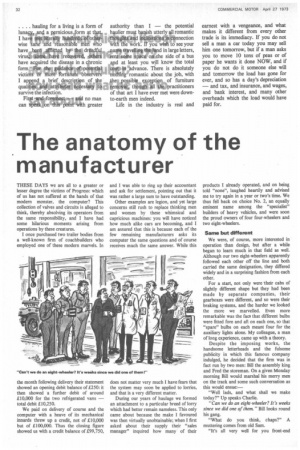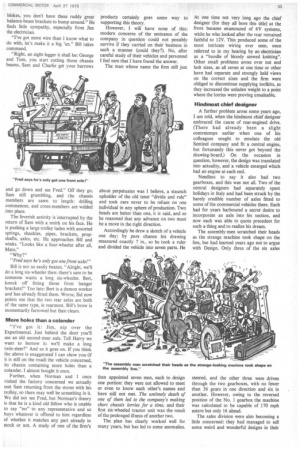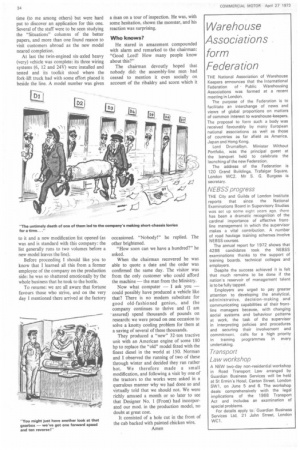The anatomy of the manufacturer
Page 34

Page 35

Page 36

If you've noticed an error in this article please click here to report it so we can fix it.
THESE DAYS we are all to a greater or lesser degree the victims of Progress: which of us has not suffered at the hands of that modern monster, the computer? This collection of valves and circuits is alleged to think, thereby absolving its operators from the same responsibility, and I have had some hilarious moments arising from operations by these creatures.
I once purchased two trailer bodies from a well-known firm of coachbuilders who employed one of these modern marvels. In the month following delivery their statement showed an opening debit balance of £250: it then showed a further debit of around £10,000 for the two refrigerated vans — total debit £10,250.
We paid on delivery of course and the computer with a heave of its mechanical innards threw up a credit, not of £10,000 but of £100,000. Thus the closing figure showed us with a credit balance of £99,750, and I was able to ring up their accountant and ask for settlement, pointing out that it was rather a large sum to have outstanding.
Other examples are legion, and yet large concerns still rush to replace thinking men and women by these whimsical and capricious machines: you will have noticed how much alike cars are becoming, and I am assured that this is because each of the few remaining manufacturers asks its computer the same questions and of' course receives much the same answer. While this does not matter very much I have fears that the system may soon be applied to lorries, and that is a very different matter.
During our years of haulage we formed an attachment to a particular breed of lorry which had better remain nameless. This only came about because the make I favoured was then virtually unobtainable; when I first asked about their supply their "sales manager" inquired how many of their
products I already operated, and on being told "none", laughed heartily and advised me to try again in a year or two's time. We thus fell back on choice No. 2, an equally eminent name among the "specialist" builders of heavy vehicles, and were soon the proud owners of four four-wheelers and two eight-wheelers.
Same but different
We were, of course, more interested in operation than design, but after a while began to learn much in that field as well. Although our two eight-wheelers apparently followed each other off the line and both carried the same designation, they differed widely and in a surprising fashion from each other.
For a start, not only were Their cabs of slightly different shape but they had been made by separate companies, their gearboxes were different, and so were their braking systems, and the harder we looked the more we marvelled. Even more remarkable was the fact that different bulbs were fitted fore and aft on each one, so that "spare" bulbs on each meant four for the auxiliary lights alone. My colleague, a man of long experience, came up with a theory.
Despite the imposing works, the handsome letterheads and the fulsome publicity in which this famous company indulged, he decided that the firm was in fact run by two men: Bill the assembly king and Fred the storeman. On a given Monday morning Bill would marshal his merry men on the track and some such conversation as this would ensue:—
"Well lads, and what shall we make today?" Up speaks Charlie.
"Can we do an eight-wheeler? It's weeks since we did one of them." Bill looks round his gang.
"What do you think, chaps?" A muttering comes from old Sam.
"It's all very well for you front-end blokes, you don't have these ruddy great balance-beam brackets to hump around." He finds little sympathy, especially from Jim the electrician.
"I've got more wire than I know what to do with, let's make it a big 'un." Bill takes command.
"Right, an eight-legger it shall be: George and Tom, you start cutting those chassis beams, Sam and Charlie get your barrows
and go down and see Fred." Off they go, SIMI still grumbling, and the chassis members are sawn to length: drilling commences, and cross-members are welded into place.
The feverish activity is interrupted by the return of Sam with a smirk on his face. He is pushing a large trolley laden with assorted springs, shackles, pipes, brackets, propshafts, axles, etc. He approaches Bill and winks. "Looks like a four-wheeler after all, M ate," "Why?"
"Fred says he's only got one front axle!"
Bill is not so easily beaten. "Alright, we'll do a long six-wheeler then: there's sure to be someone wants a long six-wheeler. Bert, knock off fitting those front hanger brackets!" Too late: Bert is a demon worker and has already fitted them. Worse, Sid now points out that the two rear axles are both of the same type, ie rearmost. Bill's brow is momentarily furrowed but then clears.
More holes than a colander
"I've got it: Jim, nip over the Experimental. Just behind the door you'll see an old second-steer axle. Tell Harry we want to borrow it: we'll make a long twin-steer!" And so it goes on. If you think the above is exaggerated I can show you (if it is still on the road) the vehicle concerned, its chassis containing more holes than a colander. I almost bought it once.
Further, when Norman and I once visited the factory concerned we actually met Sam returning from the stores with his trolley, so there may well be something in it. We did not see Fred, but Norman's theory is that he is a kind old fellow who is unable to say "no" to any representative and so buys whatever is offered to him regardless of whether it matches any part already in stock or not. A study of one of the firm's products certainly goes some way to supporting this theory.
However, I will have none of this: modern concerns of the eminence of the company in question could not possibly survive if they carried on their business in such a manner (could they?). No, after careful study of their vehicles and personnel I feel sure that I have found the answer.
The man whose name the firm still just about perpetuates was I believe, a staunch upholder of the old tenet "divide and rule" and took care never to be reliant on one individual in any sphere of production. Two heads are better than one, it is said, and so he reasoned that any advance on two must be a move in the right direction.
Accordingly he drew a sketch of a vehicle one day; by pure chance his drawing measured exactly 7 in., so he took a ruler and divided the vehicle into seven parts. He
then appointed seven men, each to design one portion: they were not allowed to meet or even to know each other's names and have still not met. The untimely death of one of them led to the company's making short chassis lorries for a time, and their first six-wheeled tractor unit was the result of the prolonged illness of another two.
The plan has clearly worked well for many years, but has led to some anomalies. At one time not very long ago the chief designer (for they all bore this title) at the front became enamoured of 6V systems, while he who looked after the rear remained faithful to 12V. This produced some of the most intricate wiring ever seen, once referred to in my hearing by an electrician as a "bundle of bloody stewed knitting". Other small problems arose over nut and bolt sizes, as all seven at one time or other have had separate and strongly held views on the correct sizes and the firm were obliged to discontinue supplying toolkits, as they increased the unladen weight to a point where the lorries were proving unsaleable.
Hindmost chief designer
A further problem arose some years ago, I am told, when the hindmost chief designer embraced the cause of rear-engjned drive. (There had already been a slight contretemps earlier when one of his colleagues sought to emulate the old Sentinel company and fit a central engine, but fortunately this never got beyond the drawing-board.) On the occasion in question, however, the design was translated into actuality, and a vehicle emerged which had an engine at each end.
Needless to say it also had two gearboxes, and this was not all. Two of the central designers had separately spent holidays in Italy and had been struck by the barely credible number of axles fitted to some of the commercial vehicles there. Each had for years harboured a secret desire to incorporate an axle into his section, and now each was able to quote precedent for such a thing and to realize his dream.
The assembly-men scratched their heads as the strange machine took shape on the line, but had learned years ago not to argue with Design. Only three of the six axles steered, and the other three were driven through the two gearboxes, with no fewer than 36 gears in one direction and six in another. However, owing to the reversed position of the No. 1 gearbox the machine was calculated to be capable of 170 mph astern but only 16 ahead.
The sales division were also becoming a little concerned: they had managed to sell some weird and wonderful designs in their
time (to me among others) but were hard put to discover an application for this one. Several of the staff were to be seen studying the "Situationscolumns of the better papers, and more than one found reason to visit customers abroad as the new model neared completion.
At last the twin-engined six-axled heavy (very) vehicle was complete: its three wiring systems (6, 12 and 24V) were installed and tested and its toolkit stood where the fork-lift truck had with some effort placed it beside the line. A model number was given to it and a new modification list opened (as was and is standard with this company: the list generally runs to two volumes before a new model leaves the line).
Before proceeding I should like you to know that I learned all this from a former employee of the company on the production side: he was so shattered emotionally by the whole business that he took to the bottle.
To resume: we are all aware that fortune favours those who strive, and on the very day I mentioned there arrived at the factory a than on a tour of inspection. He was, with some hesitation, shown the monster, and his reaction was surprising.
Who knows?
He stared in amazement compounded with alarm and remarked to the chairman: "Good Lord! How many people know about this?
The chairman devoutly hoped that nobody did: the assembly-line men had ceased to mention it even socially on account of the ribaldry and scorn which it occasioned. "Nobody!" he replied. The other brightened.
"How soon can we have a hundred?" he asked.
When the chairman recovered he was able to quote a date and the order was confirmed the same day. The visitor was from the only customer who could afford the machine — the man from the Ministry.
Now what computer — I ask you — could possibly have produced a vehicle like that? There is no modern substitute for good old-fashioned genius, and the company continues to thrive and (I am • assured) spend thousands of pounds on research: we were proud on one occasion to solve a knotty cooling problem for them at a saving of several of these thousands.
They produced a "new" 32-ton tractive unit with an American engine of some 180 hp to replace the "old" model fitted with the finest diesel in the world at 150. Norman and I observed the running of two of these through winter and decided they ran rather hot. We therefore made a small modification, and following a visit by one of the tractors to the works were asked in a querulous manner why we had done so and virtually told that we should not. We were richly amused a month or so later to see that Designer No. I (Front) had incorporated our mod. in the production model, no doubt at great cost.
It consisted of a hole cut in the front of the cab backed with painted chicken wire. Amen












































































































